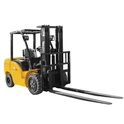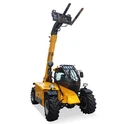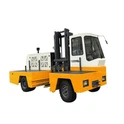1. Introduction: The Efficiency Backbone of Global Trade
The continuous growth of global trade has fueled an ever-increasing demand for highly efficient container handling equipment in ports and logistics hubs worldwide.
In the challenging, space-constrained environment of container yards, one heavy machine stands out as the undisputed core of operations, thanks to its superior vertical stacking capability and flexible horizontal maneuverability: the Reach Stacker. Also commonly known as a Front Loader or container handler, it is crucial for maximizing throughput.
This article will explore the structure, core reach stacker advantages, diverse applications, and future trends of this vital piece of port equipment, guiding you on how to choose the right model for your business.
2. What Is a Reach Stacker (Front Loader)?
A Reach Stacker is a large, specialized lifting and transporting vehicle designed specifically for the efficient loading, unloading, and high-density stacking of standard ISO shipping containers.
Core Structure Breakdown:
- Telescopic Boom: The key component enabling long-distance reach and high-level stacking. It extends and retracts via a hydraulic system to precisely position the spreader over the container.
- Container Spreader: Located at the end of the boom, this device hydraulically adjusts and securely locks onto containers (typically 20ft and 40ft), ensuring safe pickup and placement.
- Chassis and Counterweight System: A robust, heavy-duty chassis provides the necessary stability. The large rear counterweight and sophisticated hydraulic balancing system prevent tipping when the boom is fully extended with a maximum load.
- Operator Cab: Ergonomically designed and usually positioned high on the frame, the cab offers the operator an expansive view crucial for accuracy and safety during high-stacking operations.
How It Works (Working Principle):
The Reach Stacker operates by extending and retracting its long boom to grab containers from trucks, railcars, or the ground. It can then stack them at designated locations or retrieve them for transport. Crucially, it can perform multi-row container handling without constantly repositioning the entire machine.



3. Core Reach Stacker Advantages in Port Operations
Compared to traditional container forklifts or gantry cranes, the Reach Stacker offers compelling benefits in modern ports and logistics centers:
| Advantage | Description | Key Impact |
| High Stacking Capacity | Can safely and stably stack containers five or more high, far exceeding conventional forklifts. | Significantly increases yard density and space utilization. |
| Flexible Operation | Capable of effective loading and unloading even when accessing the second or third container row. | Reduces costly container double-handling, improving turnaround efficiency. |
| Superior Mobility | High travel speed and excellent maneuverability allow rapid transfer between different work areas. | Adapts quickly to changing logistics demands and reduces non-productive time. |
| Cost Efficiency | One Front Loader can replace multiple traditional pieces of port equipment, reducing dependence on fixed infrastructure. | Saves on-site investment and long-term labor costs. |
4. Real-World Reach Stacker Applications
The versatility of the Reach Stacker makes it indispensable across various container handling environments:
- Port Terminals: The primary application, where they are used for fast transfer between the vessel loading area and the container handling yard, enabling high-density stacking.
- Rail Terminals: Essential in inland rail yards, as they can easily traverse tracks to stack multiple rows of containers and facilitate rapid rail transfer operations.
- Inland Logistics Hubs (Dry Ports): Crucial for container storage, repair, and optimizing the flow of goods within major warehousing and distribution centers.
5. Selecting the Right Reach Stacker: A Buying Guide
Choosing the ideal model requires precisely matching the equipment to your operating environment and specific demands:
A. Capacity Matching
The most common and versatile model, designed to handle fully loaded 40ft containers

45 Ton Diesel Reach Stacker
The reach stacker container handler equipped with a Cummins engine, Linde pump and control valve, intelligent hydraulic oil cooler, full CAN bus control system, and has engine protection system is designed for improving your logistic working jobs.
45 Ton Electric Reach Stacker
The 45-ton reach stacker is electrically powered and has significant environmentally friendly features, with low noise levels and zero emissions. In addition, it is cheaper to use than the low diesel-driven one; the cost of electricity consumption is about 30% of the cost of diesel.

B. Lifting Height and Operating Radius
Always consult the machine's capacity chart to ensure that at your actual stacking height (e.g., 5-high) and operating radius (e.g., reaching the second row), the reach stacker maintains the required safety load rating.
C. Powertrain Selection
Diesel: The traditional, reliable choice, offering robust power for long-duration, high-intensity operations. Consideration must be given to local emission standards.
Electric/Hybrid: The inevitable trend for port equipment.
D. Operability, Safety, and Maintenance
Prioritize models equipped with advanced safety control systems (anti-tip, spreader fault detection), comfortable cabs with excellent visibility, and designs that facilitate easy daily checks and maintenance for long-term operational stability.
6. Future Trends in Reach Stacker Technology
Reach stackers are moving toward smarter and more sustainable designs to meet the demands of future digital ports:
- Electrification and Low Emissions: The maturation of lithium battery and fuel cell technologies will accelerate the adoption of the electric reach stacker, meeting global mandates for zero-emission port operations.
- Smart Monitoring and Automation: Integration of GPS, sensors, and video analysis enables precise stacking management, paving the way for remote control or semi-automated stacking systems.
- Port Digital Interconnection: The reach stacker will function as a terminal within the Port Operating System (TOS), uploading real-time data and seamlessly collaborating with other container handling equipment.
7. Conclusion: Efficiency, Safety, and Sustainability
The Reach Stacker is an indispensable piece of heavy port equipment that powerfully supports the high-speed operation of the global supply chain. Moving forward, efficiency, safety, and sustainability will be the three key drivers of its continued development.
We are committed to providing innovative reach stacker solutions that meet the demands of the future port, helping your logistics operations achieve greater efficiency and environmental performance.
Learn More: Ready to find the most reliable and advanced port equipment solution for your container yard? Contact us now!








